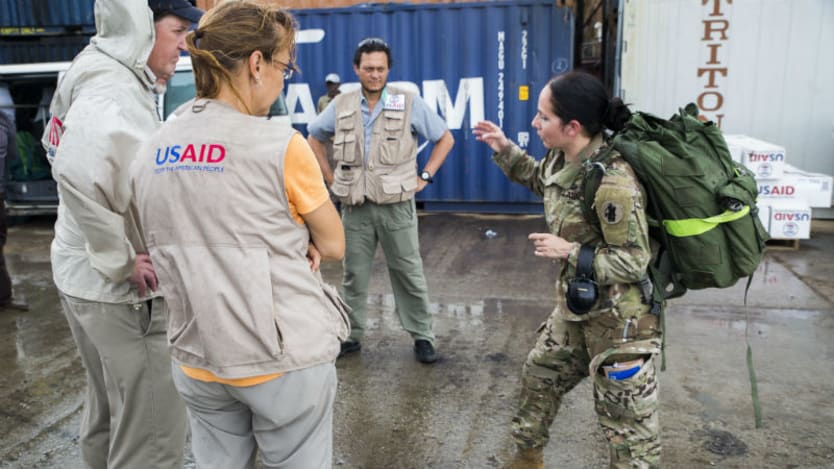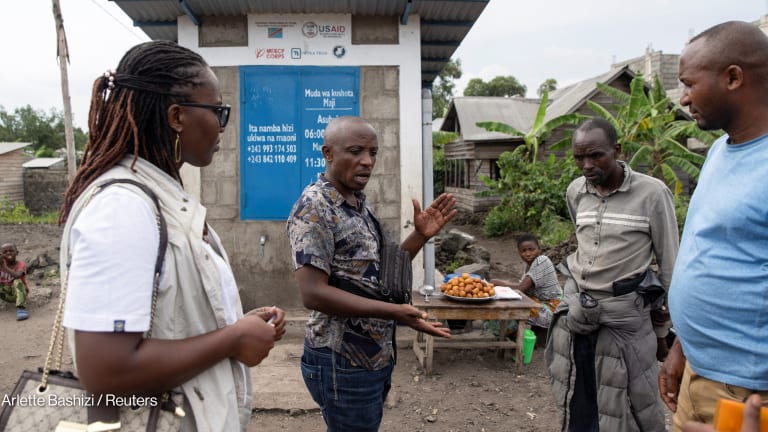
WASHINGTON — In February Devex published an article that explored a U.S. Agency for International Development proposal to establish “rapid expeditionary development” — or RED — teams. It evoked a strong reaction.
The concept of RED teams was developed by USAID’s Global Development Lab as a potential option for expanding the agency’s ability to operate in fragile and conflict-affected environments. As envisioned, RED team members would be specially recruited, trained, and embedded with “nontraditional” partners, potentially including U.S. special forces, in hopes of allowing the agency to pursue development objectives in insecure environments — to operate “outside the wire.”
Read the Devex article: USAID mulls proposal to train aid workers as special forces
USAID is looking for new options in nonpermissive environments. One of them involves training development professionals to work alongside military special forces.
The lab commissioned a consulting firm, Frontier Design Group, to conduct a “demand and feasibility assessment” of the RED team concept, which was published in February 2018. Alexa Courtney, CEO and founder of Frontier Design Group and an author of that assessment, spoke to Devex about the feedback she has received since publication of the Devex article, and what she considers some of the key messages contained in the report.
Courtney noted that, though she is a former USAID employee, she was not speaking on behalf of the agency.
“Imagine a role for this kind of a team in Ebola response in some of the most difficult places in the DRC right now.”
— Alexa Courtney, CEO and founder, Frontier Design GroupThis interview has been edited for length and clarity.
In the wake of the article we published, you've had a lot of interesting follow-up conversations about the research that you did, the RED team concept, and other issues related to civilian-military coordination. How did these conversations come about?
People emailed me, and that ranged from a lieutenant general from the special forces community, to large USAID implementing partners, people who used to be at [US]AID who served in leadership positions and had experience in missions in very volatile environments … Then there were some interesting threads on LinkedIn that I didn't choose to weigh in on, but I watched, and I think that's where some of the more critical commentary came out.
In the [USAID Office of Foreign Disaster Assistance] context, in particular, there was a very heated debate among folks who were really against the RED team concept, which is one of the reasons why ... I reached out to former administrator [Andrew] Natsios. He was my administrator when I was at AID, and I asked him what he thought about the RED team concept.
I didn't realize this, but about two weeks before I emailed him in mid-March he said that he had just testified recently before the House Foreign Affairs Subcommittee on Oversight, and in that testimony ... he said he endorsed the RED team concept, and in fact he did. And in [his] email … he said: “I do support the RED team concept, as that was what we hoped the [Disaster Assistance Response Team] would eventually evolve into.”
To me this is significant because he was a former AID administrator when I served there. He's a longtime humanitarian. He's very vocal on the impact of development assistance and the importance of development assistance, and has paid a lot of attention to the evolution of AID business models over time.
“The people who believe that AID is clearly part of the foreign policy architecture of our government and has a contribution to make toward our national security were much more open-minded to the RED team concept.”
—But in his testimony, as you will see, he's also saying it's really important to have AID and development assistance be linked to foreign policy and our national security. And I think that's really where the debate faultline was that I noticed in all of the reaction. The people who believe that AID is clearly part of the foreign policy architecture of our government and has a contribution to make toward our national security were much more open-minded to the RED team concept.
Why do you think that equipping development professionals in this way equates to placing them more centrally within the U.S. foreign policy architecture? What's the link there?
The RED team is, I think, a potentially liberating structure that allows AID officers — again, I want to be clear I'm not speaking for AID, this is my opinion — but that allows development professionals to leverage their unique development and stabilization expertise. When you look at AID's policy framework, which just came out [in April], they talk about where AID works, and I found these figures to be really interesting that ... “a majority of countries in which USAID works exhibit a significant degree of fragility: Roughly 20% are in acute crisis; 20% are either recovering from or prone to crisis; and 40% experience, or are at risk of, smaller-scale shocks and stresses, such as communal violence and rampant crime.”
The link for me is that — one, USAID is a bilateral U.S. government donor [whose] current reporting structures are ... through the secretary of state. So of course there is a direct linkage, hand-in-glove, development and foreign policy connection.
What then do you think struck a chord? You mentioned that the fault line was between people who agree with that assessment that AID is firmly part of the U.S. foreign policy architecture and people who don't? Is it that simple or is there something about this specific proposal that you think garnered particular attention?
So I noticed, in the people who reached out to me, they had read the actual report. A lot of people, I believe — this is just an observation — who were contributing to the LinkedIn conversations, had not read the report but had read your article and definitely had been primed by the headline.
As far as I could tell there was a lot of reaction and weighing in to a seemingly very controversial concept, aspects of which have been happening all over for a while now. AID has been working closely with DoD in a number of contexts.
Lieutenant General Michael Nagata, who is a three star Green Beret who just retired earlier this month, [is] one of the people that reached out to me after the article came out and talked about ... the importance of AID being more effective and more expeditionary than it already is, and that we need far greater — these are General Nagata's words — "policymaker investment, resourcing, and policy support for AID, developing a civilian workforce that is able to lead and take proper interagency responsibility for increasingly important strategic interest the U.S. government has in fostering greater human development around the world."
More news from USAID:
► USAID takes broader view of local procurement
► Q&A: USAID's chief innovation officer on whole-of-agency integration
► In 'enlightening' USAID budget hearing, new chairman calls for careful scrutiny
I've had an ongoing conversation with General Nagata and really respect his leadership. I think he is very well respected within USAID circles, because he is such a proponent of flipping our mental paradigm from AID being in service to military campaigns or a support role and it going the other way, to have really military being in support, in high-threat fragile states, of a broader development mission when we're talking about stabilization.
There are so many contexts where there will never be any military on the ground, in high threat environments that are not declared combat missions ... and you still need an AID expeditionary capability.
You could imagine a role for this kind of a team in Ebola response in some of the most difficult places in the DRC right now, which is very different than the context that was picked up in some of these [online] chains.
Part of that is probably based on both real past experience and also concerns that people have about making development objectives secondary to narrower national interests.
Yeah, and I can't pretend to know what is in people's heads when they react. My role was to share with them what I believed to be the intention of the concept, which was very broad, very applicable to a wide range of co-embeddedness with small teams, and that could be everything from working closely with the Department of Commerce colleagues in a particular environment, or U.S. public health officials, to some of the ones that were profiled in the report.
This is a moment where it's an opportunity to think about experimental or prototype business models. What worked or what didn't a year ago, a decade ago, is very different than what might work tomorrow, because the pace of change is so unbelievably rapid in all of these environments, particularly in fragile and conflict-affected environments or in crisis contexts.
I think the RED team ... is a powerful idea to think about how to be more effective and expeditionary in an experimental way with a wider range of partners that very importantly allows AID to leverage its development and technical expertise in places where they currently cannot go or access.
“Getting this very intensive training ... helps you understand what you actually do in a fight, flight, or freeze context.”
—Whether or not the specific RED team proposal moves forward, do you feel like you were able to uncover some important questions or needs around preparedness that the agency might address through this proposal or through other proposals in the future?
I do think it puts a real primacy on preparedness as a mindset and a skill set.
If you read the RED team report alongside the Civilian Response Corps after-action [report], the genius of having four different reports that the Global Lab commissioned together — we did them in sequence but all under the same contract — was we looked back in order to look forward. Understanding what worked and what didn't for the Civilian Response Corps at AID was really important.
Consistently people would flag this training called "security for nontraditional operating environments," or SNOE training ... This was a very atypical training curriculum for anyone who was a part of the Civilian Response Corps. It was about surveillance detection, hostage survival, personal safety practices, weapons familiarization, all of that ... It's no longer offered.
The gap I want to point to, and one I think is particularly profound, is you see journalists, and folks at foundations, and a number of other places getting this very intensive training that helps you understand what you actually do in a fight, flight, or freeze context, and to have at least some of the awareness, if not eventually the skills, to understand how to engage in these environments and how you're going to instinctively react and how to condition that reaction.
I was talking to a couple of colleagues who had been previously in the DoD community as civilians, but who are now working for AID implementing partners, and they had really extensive training as civilians — how to get off the X, how to get out of restraints ... Now that they're working for AID implementing partners they're going to very challenging environments around the world with absolutely no training, and I think it's been a particularly stark contrast for them.
Folks need to be prepared so they can feel empowered, that if and when they encounter a very dangerous or very difficult situation that they have simulated it, that they have practiced the skill sets. I think that that preparedness is really important and goes a long way to helping make sure that development professionals are able to do the best development work or provide their best expertise in a stabilization context or whatever the context is in the future.
“‘Operational empathy’... to understand when you're embedded in a broader interagency context, what are the interests and the equities, and the operating capacities of ‘the other.’”
—At a certain point is it no longer possible to achieve good development outcomes when they're hitched up to something else, like a military or even a commercial objective?
The RED team concept is not a concept that would fit every context or every development or stabilization need. As I understood it, the idea of a RED team would be as a very specialized platform or operational concept that would allow a very unique kind of expertise from AID to be leveraged in very, very challenging environments. So it's highly specialized for a very specific kind of environment.
I think the larger question that you're asking — someone in our study used the term ... "operational empathy." I think that's really interesting, to understand when you're embedded in a broader interagency context, what are the interests and the equities, and the operating capacities of "the other," whoever that is — if that's a Department of Commerce official or if that's someone in the military. And vice versa — having that military officer or that Department of Commerce official understand what USAID's interests and equities and operational capabilities and capacities are.
So I think that concept of operational empathy in the RED team concept is really, really important. And as a part of that you would be assessing — is there alignment in a way that allows broader U.S. government foreign policy goals and objectives? And if so how? What role can a person who is representing AID play? What is the development expertise required that is necessary that can integrate effectively?
It really depends on the context, the goals and objectives, and what role development plays, which does take me back to General Nagata's point that ... we have to flip our mental paradigms for how the military should be in support of development campaigns and development objectives instead of the other way around.
“Where there are no military assets on the ground, thinking about what a RED team looks like there is really important.”
—That implies that the paradigm that currently exists is that development currently serves national security or military objectives in a lot of cases.
This is where it's really important to understand what mental model someone is bringing to this conversation. I think definitely there could be the perception among some that you just articulated. But … AID is a government agency, a U.S. government agency. It's the world's largest bilateral donor.
A majority of countries in which AID works exhibit a significant degree of fragility. In those environments where there is a fragile state, or there's high conflict, or it's nonpermissive for whatever reason ... where it is particularly difficult for AID to work currently using some of its models, this is an opportunity potentially to do something different and to augment some of the capabilities.
One of the people who reached out to me ... had been a senior State Department official, serving at the deputy assistant secretary level and then as a very senior Hill staffer. He shared that when he went out as a part of a congressional delegation ... to places like the border with Syria and Jordan or places like Somalia or the Lake Chad Basin region, they were oftentimes considered VIP visitors, but they were able to get out and see and engage in places where civilians under chief of mission authority could not go.
And I believe the way they were able to do that is the chief of mission — the ambassador who's responsible for all U.S. government official civilians in his or her country — delegated responsibility for the security of those congressional staffers to U.S. military in the country or the region.
It's become even more difficult post-Benghazi to find ways to get AID officers closest to the community that they are serving — or "outside the wire." There are a variety of reasons that I understand why it is so difficult under chief of mission authority, but there are definitely examples across the board ... of where there have been workarounds.
I'm sure that folks inside AID and State who are affected by this all the time are probably thinking very deeply about how to address this very systemic challenge, because I'm sure they feel frustrated.
As you received — or observed — lots of different responses, have your views about this proposal changed at all?
I still really believe there is an important need and that this could be a powerful augmentation to other AID operational models.
I guess the thing that I have come to appreciate through a lot of these conversations is one of the original insights of AID's concept, which is it could be used in so many other kinds of contexts. Particularly in my exchange with General Nagata, where there are no military assets on the ground, thinking about what a RED team looks like there is really important.
So I think I've, if anything, broadened my view of the applicability in the environmental context of RED teams, while still appreciating the original wisdom in the mindset, skill set, preparedness that AID believed RED teams would need when they asked us to look at the concept.
Read the original Devex article: USAID mulls proposal to train aid workers as special forces.








